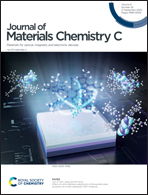Screen-printable and stretchable hard magnetic ink formulated from barium hexaferrite nanoparticles
Abstract
Stretchable electronics have seen an increase in interest for applications in medicine, sensing, and robotics. Current stretchable materials are either intrinsically stretchable, are patterned into stretchable architectures, or are made by forming a composite of some stretchable material and a rigid material with some desired property, such as high conductivity. However, there is a lack of stretchable magnetic materials available in the literature, and devices that combine stretchability and magnetics are limited to using serial fabrication processes such as embedding millimeter scale pieces of magnet into polymer matrices. In this work, a stretchable composite hard magnetic ink made by mixing barium hexaferrite nanoparticles with 9510 one-part epoxy potting compound and di(propylene glycol)methyl ether is presented. Using screen printing methods, the ink is then used to fabricate a magnetic strain sensor, which acts as a proof-of-concept for the material and process. Results indicate that a stretchable hard magnetic ink can be made that provides a remnant magnetization of 20 kA m−1 from the barium hexaferrite particle inclusions, as well as a stretchability of at least 100% strain from the epoxy.



 Please wait while we load your content...
Please wait while we load your content...